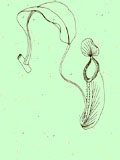

 |
Air pollution and biodiversity in Hong Kong (pdf)
Nobody doubts that air pollution in Hong Kong is a major threat to human health, and nobody doubts that water pollution in Hong Kong is a major threat to freshwater and marine biodiversity. But what about the effects of air pollution on terrestrial biodiversity? This is an important question because the entire conservation strategy for terrestrial biodiversity in Hong Kong is based on the assumption that protecting areas – as Country Parks, Special Areas, SSSIs or whatever – protects species. Yet, as marine biologists know only too well, pollution does not respect park boundaries.
The only research on this problem in Hong Kong was into the effects of sulphur dioxide pollution on lichens (Thrower, 1980). High levels of this pollutant in the 1960s and 70s eliminated most lichens from urban areas and the most sensitive species from the whole of Hong Kong, but sulphur dioxide levels are now declining and there is some evidence of a recovery in lichen populations. Other pollutants, however, are getting worse. Most conspicuous over the last decade has been the regional haze that blankets large areas of southeastern China for much of the year, reducing the amount of sunlight reaching the ground by 5-30% (Chameides et al., 1999). Although this reduction may have serious implications for crop yields, photosynthesis in wild plants is more likely to be limited by water and/or nutrients, so unshaded leaves usually receive more sunlight than they can use.
The big worry is ozone (Corlett, 2001). Ozone is unique among air pollutants in that, although it is produced by reactions involving urban pollutants, urban ozone levels are reduced by reactions with nitrogen oxides so that the maximum levels occur downwind of cities, in rural areas (Gregg et al., 2003). Thus ozone concentrations measured at the Hong Kong Polytechnic University monitoring station at Cape D’Aguilar, in the remote southeastern tip of Hong Kong Island, often exceed those measured in urban areas, and the highest recorded hourly value in Hong Kong was in Tung Chung last September. There is no reason to believe that these sites are exceptional, but there has been very little monitoring of ozone in rural Hong Kong. Moreover, while much of Hong Kong’s ozone is generated locally, there are also regional high ozone events, covering much of eastern China, which would impact Hong Kong even if it were uninhabited.
Peak ozone concentrations measured in Hong Kong are within the range that has been shown to damage both crops and wild plants in Europe and North America. Ozone reduces photosynthesis and plant growth, as well as causing visible damage to leaves. We have no direct evidence that such damage is occurring locally, but the visible symptoms are easily confused with other forms of natural damage, and no detailed study has been carried out. Regional ozone concentrations are predicted to continue rising for at least the next decade, so this is a problem that can only get worse.
Bibliography
Chameides, W.L., Yu, H., Liu, S.C., Bergin, M., Zhou, X., Mearns, L., Wang, G., Kiang, C.S., Saylor, R.D., Luo, C., Huang, Y., Steiner, A. & Giorgi, F. (1999). Case study of the effects of atmospheric aerosols and regional haze on agriculture: an opportunity to enhance crop yields in China through emission controls? PNAS 96: 13626-13633.
Corlett, R.T. (2001). The potential impacts of air pollution on biodiversity in Hong Kong. In: A.T. Chan, A.J. Hedley, P.R. Hills & J.H. Zhong (eds.) The air we breathe: air pollution in Hong Kong. University of Hong Kong.
Gregg, J.W., Jones, C.G. & Dawson, T.E. (2003). Urbanization effects on tree growth in the vicinity of New York City. Nature 424: 183-187.
Thrower, S.L. (1980). Air pollution and lichens in Hong Kong. Lichenologist 12: 305-311.
P.1
|
Porcupine! |
 Copyright © 2000 |